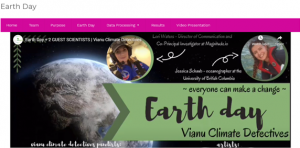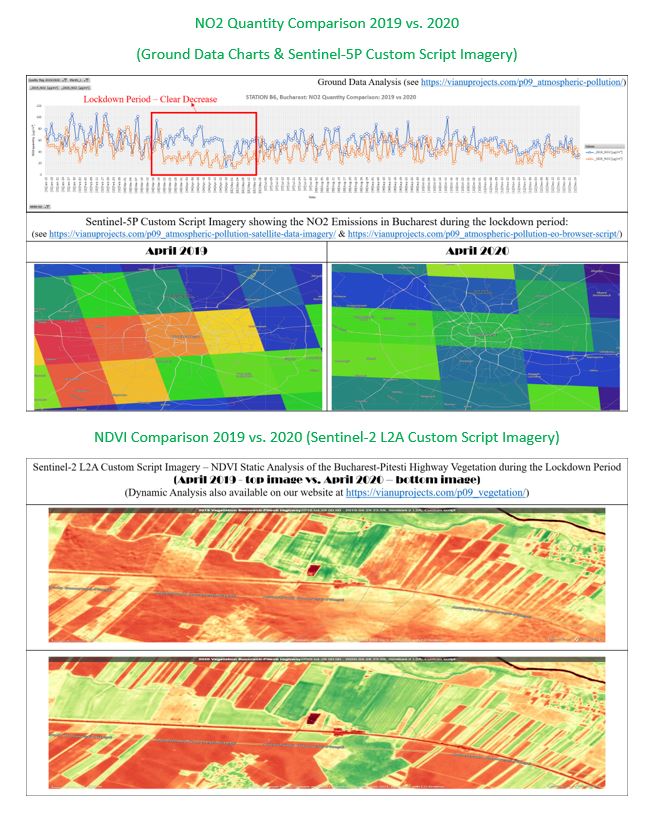Climate Detectives Projects 2020-2021
Topics
Project title: Climate Changes Post COVID-19 Lockdown
Team: Vianu Climate Detectives Highly Commended Project
Tudor Vianu National High School of Computer Science Bucharest Bucharest Romania 14 6Student’s age: 14-15 years old
Have the imposed restrictions had a direct impact on greenhouse gas emissions and vegetation or even on the “classical” four seasons?

Considering that 2020 was marked by the COVID-19 lockdown, we have investigated whether the imposed restrictions have had a direct impact on the greenhouse gas emissions and vegetation both in our local area and nationally. Within this study, we also tried to prove a delay of the classical four seasons during the pandemic, when increased vegetation emerged earlier. We firmly divided our analysis in two sections: Air Pollution and Vegetation.
Initially, we planned on investigating the CO2 emissions, but no satellite provides such information yet. However, a lesson learnt within this project was not to give up, but instead to find alternative solutions. We started studying other dangerous gases which can lead to the greenhouse effect or even harm one’s respiratory system when pollution is produced in exhaust pipes. Subsequently, we split the Air Pollution segment into three branches:
• Ground Data (source: Ministry of Environment website – daily NO2, CO, and SO2 amounts in stations from 15 Romanian counties in 2019 and 2020)
• Satellite Data & Imagery (Sentinel-5P NO2 emissions in Bucharest)
• EO Browser Script (additional processing with a custom script we adapted).
For the Vegetation component, we also used a Sentinel-2 custom script to analyse the NDVI (Normalized Difference Vegetation Index), an indicator assessing whether or not an area contains live green vegetation.
Another concern was to thoroughly understand essential concepts like NO2 vertical column, NDVI, TROPOMI, Sentinel-2 & Sentinel-5P facilities or custom scripts, topics which we researched in-depth and explained in the Theoretical Aspects section of our website.

Firstly, processing ground data from 15 counties enabled us to observe that NO2 emissions were highly affected by the lack of traffic, whereas SO2 and CO amounts were similar in 2019 and 2020. For instance, in Bucharest (similarly to most big cities), the decrease is intelligible during the lockdown (March 16-May 14) when the amount of NO2 reached 20-40 μg / m³ in 2020 and 50-80 μg / m³ in 2019.
Furthermore, the decreasing trend was confirmed as we analysed satellite imagery with the help of the TROPOMI instrument of the Sentinel-5P. Our approach consisted of using the colour code of NO2 emissions, from dark blue (insignificant quantities) to dark red (alarming emissions). However, we noticed the colour intervals were too large, so only huge differences were plotted. Consequently, we adapted the java script code to distinguish any change. The results show an explicit decrease in NO2 emissions in Bucharest 2020 (blue: small amounts) from 2019 (red & green: higher levels of NO2).
By using a Sentinel-2 L2A custom script, we examined the NDVI of images from 2019 compared to 2020 in representative locations: the Kiseleff Park (our school area), the Bucharest-Pitesti highway (extreme traffic), and the Endless Column Park in Gorj County (well-known green area). In all cases, we conclude that the NDVI was higher in 2020, the vegetation emerging earlier than the usual timeline.
Ultimately, we assess the COVID-19 restrictions resulted in the reduction of NO2 emissions caused by traffic as well as the sudden increase in vegetation.

We are currently at our third participation in the European Space Agency Climate Detectives School Project, and each year we extend our campaign to raise awareness and fight for environmental protection. This year on Earth Day (April 22), we have gone one step further and had two brilliant guest scientists: Jessica Schaub (CAN) – an oceanographer at the University of British Columbia, and Lori Waters (USA) – the director of communications and co-principal investigator of the ExoLab-8 mission to the International Space Station, both of whom insightfully answered all our questions and gave us precious advice on protecting the environment. We also discussed the European Green Deal, which aims to reduce the emissions of greenhouse gases by 50% until 2050. The YouTube link of the event is https://youtu.be/KHsK2hv_s3g.
Subsequently, besides presenting our project inside our school community, we know a study is valueless if it is not accessible to the large public. Thus, as we believe authorities are the most influential decision-makers, we contacted the town hall and shared the results of our project with them via email. Moreover, we created an improved website (https://vianuprojects.com/) where we share all our projects, events, and interviews with scientists. In this way, we succeed in drawing one’s attention to our work and advertising future get-togethers for the wellness of our planet. Looking ahead, we plan to keep on organizing educational events on how to stop the climatic crisis, so if you want to be the first to attend, stay tuned to our website!
https://vianuprojects.com/p09_2020-2021_esa_climate-detectives/
Projects are created by the teams and they take the full responsibility of the shared data.
← All projects






